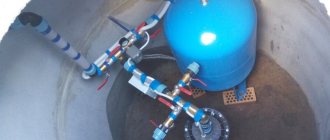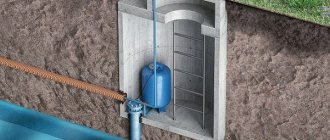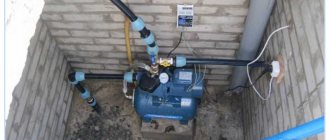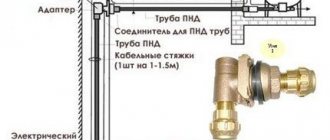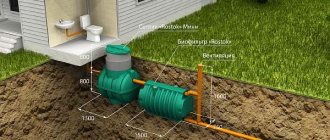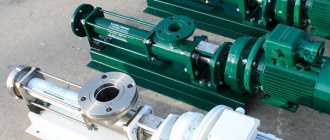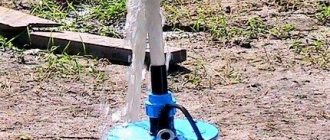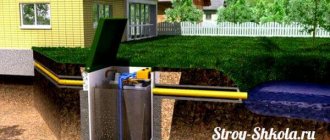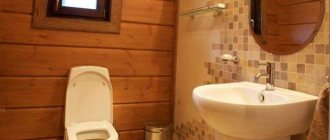The problem of supplying water to private houses located far from the centralized infrastructure was solved by installing wells, installing pumping equipment and connecting pipes to the house. As a result, the home owner receives full-fledged running water. A well, as a source of water, must be well protected from various negative influences. Why is a special device installed at its mouth - a caisson.
A caisson is a sealed cylindrical structure made of concrete, plastic, metal, approximately two meters deep. At the bottom of the cylinder is the base of the well. The caisson must be installed with a hatch for normal access to the well.
Well caisson - what is it?
A caisson for arrangement is a waterproof tank made of metal or plastic.
Structures made from concrete rings are considered an obsolete option and are falling out of use. The reservoir can be square or rectangular in shape. Tank height: not less than 2 m, base area - not less than 1 sq. m.
Well caisson functions:
- Saving free space inside the house.
- Protection of the mouth from groundwater ingress.
- Protection of installed equipment from freezing in winter.
- Providing quick access to installed equipment.
- Silencing noise from a running pump.
produces caissons for wells under its own brand. This solution allows us to guarantee the quality of the tanks we install. And also reduce the price of equipment installation for customers.
Buden is interested: How to equip a water well after drilling - popular schemes.
Figure 1: Plastic caisson with equipment installed inside.
Basic installation recommendations
This product has quite a lot of positive aspects. It is not heated, the risk of freezing is very small. It copes well with the main purpose - to protect the source from debris, rain and other precipitation.
During installation, remember several important nuances:
- Sometimes it is squeezed out or broken by the soil and its pressure. Therefore, he has to be “anchored”. This applies not only to lightweight structures - even metal structures will benefit from this. A concrete slab is poured under the future location, and then everything else is attached.
- It is not necessary to make a concrete foundation in elevated areas that do not flood. But even then, we advise you not to make do with just a sand cushion; a good base is always needed.
- The ideal height is about 2 meters. This will make it easier to work with, and more convenient to place and bury.
- Even if all conditions are met, we recommend ditching the heating cable for electricity. This will be a great help in case of force majeure situations.
After we have figured out what a caisson for wells is and how it works, we propose to consider how to install it without wasting extra time.
It is worth noting that this technology alone is not enough. We recommend that you first study the composition of the water that the family plans to drink.
After the analysis, install an appropriate filter that will reliably protect communications and people from impurities, debris and unnecessary trace elements. You can select and purchase equipment on our website - ovteh.ru. Specialists are ready to help and answer all questions.
Characteristics of a metal caisson
Metal caissons are made of steel 4-6 mm thick. Their design includes only one weld seam. The sealed container protects the mouth from dust, from groundwater, and from freezing. The metal structure can withstand strong soil pressure well. An insulated hatch is placed on the neck. Inside there are steps made in the form of brackets.
But the metal caisson has one serious drawback. The metal is destroyed by contact with groundwater and aggressive substances contained in the soil. An anti-corrosion coating can slow down this process, but not stop it completely.
To waterproof steel tanks, we coat their walls with bitumen varnish. It is possible to additionally cover the walls with waterproofing.
We will help you with choosing a caisson
Click on the button and order a call back from the Aqualux+ manager.
Order
Service life of a metal caisson: 25-30 years.
Figure 2: Metal caisson - schematic section.
How does a caisson work?
This tank has only two main tasks, which we have already discussed above:
- protect from freezing;
- Prevent the entry of moisture, debris, drains, and chemicals.
This is a cylinder that simply serves as a kind of heated or insulated well. It is equipped with a lid, most often with a bottom, while it is sealed and reinforced, increases the strength of the entire structure and minimizes the likelihood of the ground collapsing.
Water supply pipes lead from it to the house.
Characteristics of galvanized caisson
Galvanizing improves the anti-corrosion properties of the metal. Unprotected steel easily reacts with oxygen contained in the soil. This process is called oxidation. Iron-oxygen compounds are unstable and easily destroyed. After their destruction, oxygen penetrates deeper, causing the oxidation of subsequent molecules. This is how metal corrosion occurs.
Zinc has a different mechanism of interaction with oxygen. As a result of oxidation, a protective film consisting of oxides is formed on the surface of zinc. The film prevents oxygen molecules from penetrating deeper into the metal. Also, the zinc layer provides additional protection against moisture.
Metal sheets 4 mm thick are subjected to galvanizing. Galvanized sheets are used for welding containers of various shapes. Galvanizing sheets, rather than finished products, ensures an even application of the protective layer.
Service life of a galvanized tank: 35-40 years.
Figure 3: Galvanized caisson with increased durability.
Characteristics of plastic caisson
Installing a plastic caisson is the best option for an artesian well. The plastic tank is not destroyed by water. A plastic tank will last 50-60 years. The service life of the tank coincides with the service life of the artesian well.
For the manufacture of caissons of the Aqualux Plast line, polypropylene is used. The tank design has 8 stiffening ribs. They increase the strength of the tank walls by bearing soil pressure. To increase the useful volume of the tank, we moved the stiffening ribs outward, to the outer surface of the walls.
The design of any model includes:
- Plastic tank.
- Sealed flange.
- Insulated hatch.
- Sealed hatch.
- Plastic ladder.
- Optional: locking eyes.
Reliable welds can withstand direct blows from a sledgehammer. There are hooks on the bottom of the tank for fixing in the ground. The temperature inside the plastic tank does not fall below +3C.
Prices for plastic caissons Aqualux Plast follow the link.
Figure 4: Construction of a plastic caisson.
Video description
Why the caisson was compressed is shown in this video:
Attention! In this case, hydro- and thermal insulation will not be required, but protection against compression by soil is required.
Filling a plastic caisson with concrete is mandatory. Source moikolodets.ru
To do this, the gap between the walls of the pit and the box is filled with concrete. High-strength mixture quality is not necessary in this case. As a rule, the solution is mixed in a proportion of 5 parts sand and 1 part concrete. This procedure is mandatory, even if there are stiffening ribs on the plastic box.
Differences of rectangular round shape
Both metal and plastic tanks differ in shape. Often the shape depends on the volume of the tank. In the Aqualux lines, small-volume tanks are made cylindrical, and large-volume tanks are made rectangular.
Cylindrical options are easy to install. It is easier to dig a round pit than a pit with right angles. The absence of corners ensures uniform pressure on the walls of the tank. This reduces the likelihood of leaks. Due to the absence of corners, the usable volume increases.
Rectangular options are larger in volume. An adult can stand and walk freely inside the tank. Corner connections are made by welding. The corners are strong and reliable.
Shape options do not affect the properties of the surface and its service life. Shape is not the main indicator for choosing a caisson.
Comparative table of caissons "Aqualux"
For comparison, we took models of the same volume, made from different materials:
| Option | Wall material | Wall thickness (mm) | Life time | Price, rub) |
| "Aqualux+ 1" | steel | 4 | up to 30 years old | 29 000 ₽ |
| "Aqualux Zinc 1" | Cink Steel | 4 | up to 40 years old | 31 800 ₽ |
| "Aqualux Plast 1" | plastic | 6 | from 50 years old | 42 000 ₽ |
You can see that metal tanks are cheaper than plastic ones. But their service life is shorter. Choose the type of caisson, taking into account the service life of the well and the budget for the work.
Disadvantages of a caisson made of concrete rings
We do not recommend using the option with reinforced concrete rings. There is one popular misconception associated with the installation of rings. It is believed that they are not destroyed by water, and the structure can last up to 100 years. But actually it is not.
Although concrete is indeed a durable material, it is not suitable for well improvement. The rings will gradually deteriorate after installation. But this is not the main drawback of the scheme.
The main problem is that the pipe insertion into the well cannot be made completely sealed. Water will constantly accumulate inside the lower ring.
Microcracks will form in the surface of the concrete, through which water will enter the well. Sooner or later it will penetrate the wellhead and mix with drinking water. This will lead to contamination of the source. Concrete rings are difficult to repair: leaks will occur with a certain frequency.
Buden is interested: The correct distance from the well to the house according to the standards.
Figure 5: What are you drinking? Groundwater inside the caisson entered the well.
General information
Considering the caisson, what it is in construction, the structure can be defined as a hollow sealed chamber, mostly round in shape with a diameter of approximately 1 m, which is installed on top of the well pump.
Most often, the caisson is placed in a hole dug in a circle around the casing, with the casing's mouth located at a depth of 1-5 m. At the bottom of the device there is a hole for the well, at the top it is closed with a hatch for insulation. A ladder must be installed inside, which allows you to descend to the downhole equipment.
The ladder allows you to conveniently descend for installation, repair or routine maintenance of equipment Source eurolos.ru
Why a caisson is needed for a well is to protect the pumping station from bad weather conditions, seasonal temperature fluctuations, and the penetration of underground, waste and melt water.
What is well construction?
Construction is a set of works that are carried out to create a water supply system. This concept usually includes the installation of equipment and connection of a residential building to the water supply.
We construct wells according to ready-made diagrams drawn up by engineers. All kits available for installation are listed in the table:
| Option name | Model | Pump type | Cost, rub.) |
| "Economy+" | "Aqualux+ 1" | Waterstry 2-70 | 135 926 ₽ |
| "Standard+" | "Aqualux+ 1" | Aquario 75-75 | 139 420 ₽ |
| "Comfort" | "Aqualux Plast 1" | Aquario 75-75 | 161 320 ₽ |
| "Premium" | "Aqualux+ 1" | Grundfos 2-70 | 228 676 ₽ |
| "Premium+" | "Aqualux Plast 1" | Grundfos 2-70 | 250 576 ₽ |
| "Lux" | "Aqualux+ 1" | Grundfos 3-65 | 174 326 ₽ |
| "Lux+" | "Aqualux Plast 1" | Grundfos 3-65 | 196 226 ₽ |
A warranty is issued for the installed equipment. System maintenance must be carried out once every 6 months.
Caisson installation technology
Installation begins with digging a pit. You can dig a pit and a trench for water pipes manually. This does not require the use of an excavator. The width of the pit should be such that there is at least 15 cm between the walls and the ground. The depth of the pit should be 15 cm less than the height of the tank.
Figure 6: Pit preparation.
The base of the pit is leveled. The casing pipe is cut above the level of the bottom of the pit. A hole is cut in the bottom of the tank for installation on the well. After the caisson is lowered into the pit, the connection point is sealed and insulated. A sleeve is installed at the connection point. Sealed connections are provided for the entry of pipes and cables.
Figure 7: Lowering and anchoring the caisson.
When installing the plastic caisson, a concrete ring is mounted on the neck. It serves to anchor the tank and prevents the tank from moving or floating up. The mass of the ring compensates for the low weight of the tank. After connecting the equipment, the tank is closed with a hatch.
Figure 8: Installed caisson.
Video description
The features of installing a concrete caisson are described in detail in this video:
Installation of a metal structure
Installation of an iron structure will necessarily require a concrete slab as a foundation. Before fastening the structure from the outside, it is finished with waterproofing, and the inside is coated with a primer. This is a mandatory requirement even for stainless steel. Insulation is also necessary.
Step-by-step instructions on how to make a caisson for a well:
- a hole is dug.
- The foundation is prepared - a sand and gravel cushion, and a reinforced concrete slab is installed on top.
- The well casing is cut to height.
Casing pipes must be selected taking into account the diameter of the pressure pipeline Source ytimg.com
- A caisson is installed on top of the pit on metal supports, and the pipes of the sleeve and the well must coincide.
- additional trenches are dug to bring the pipeline to the house.
- All communication systems are installed.
- thermal insulation is attached.
- the structure is covered with earth.
When considering a caisson for a well, what kind of product it is and how it will be used, it is necessary to take into account differences in the design, therefore the installation diagram sometimes changes taking into account specific tasks and conditions. But it is recommended to dig trenches for connecting communications after attaching the caisson - simply jumping over various ditches at this time is not very convenient.
Is it possible to install a caisson yourself?
Proper installation of the caisson requires professional skills and knowledge. Installation errors will lead to displacement of the tank. After self-installation, there is a high risk of flooding the tank with groundwater.
Installing the tank is quite difficult. To install the container you will need a large set of tools and materials. Installing the tank will require the efforts of 2-3 strong men. To lift a metal tank and install it in a pit, you will need special equipment. Weight of metal containers: not less than 230 kg.
Professionals will install the equipment in a few hours. Installing the equipment yourself will take from several days to a week.
By ordering equipment installation from professionals, you will save time, effort and money. You will receive a guarantee for all elements of the water supply system. (If you install it yourself, the warranty may not apply.)
Order installation from professionals
Click on the button and order a call back from the Aqualux+ manager.
Order
How the camera works
The device is a sealed container. Previously, the design was used to operate water with water, then the scope of application increased. They learned how to install devices on a well to protect its head.
If you live permanently in a private house, regular operation of the well is required in different conditions and seasons, which makes its operation difficult.
At low temperatures, the liquid rising from depth freezes, which causes the pump to rupture.
Attention! The caisson guarantees equipment protection under negative environmental influences.
The head must have a temperature above zero for the well to operate continuously. For these purposes, a caisson is used.
A special sealed chamber is dug into the ground and fixed on top of the casing. If you insulate the structure, the well will maintain a high temperature. Hermetic properties do not allow drains and groundwater to penetrate inside, and serves as protection against moisture for sensitive devices.
It is convenient to install a pump in the caisson for pumping water. The device will be protected from groundwater, rodent attacks, and various insects.
If closed, access to the well head will be limited for unnecessary people and pets.
All elements intended for use of the well are easily placed inside the caisson:
1.cleaning and filtration systems, reverse osmosis system.
2. pumping device.
3.pipes with shut-off valves having any type of drive.
4. control unit for the pump, water supply system.
The container has a neck that closes with a hatch at the top.
The height of the tank is over two meters, since the length of the casing pipe inside the tank is one to two meters.
Products can be of different geometric shapes: circle or rectangle. The circular cross-section must be more than one meter in diameter so that a person can descend into the chamber.
Important! The main thing is to choose the right size of the chamber inside the well.
The caisson is insulated from the outside.
The bottom of the tank has a special hole for the entrance of the casing pipe. On the sides of the chamber there are additional holes for connecting electrical cables and water pipes. A service ladder is installed inside the structure; the most convenient option is a folding ladder.
Is it possible to do without a caisson:
1. you will have to equip the well so that it goes into a warm room, for example, a basement. Then the equipment will not freeze, but the noise from the devices will be heard into the house.
2. You will need to install a downhole adapter in the role of a compact adapter installed in the casing pipe. The cost of the structure is cheaper than a caisson, it is easy to install. The downhole adapter complicates inspection work and well repairs. In this case, all devices must be installed inside the house.
What equipment is inside
A pumping station is needed to lift water from depth. This is one of the key elements of the water supply system. A stable supply of water to the system depends on the operation of the pump. We install branded pumps, the quality of which is beyond doubt:
- Aquario.
- Waterstry.
- Grundfos.
The hydraulic tank is not needed to store a supply of water, although this is one of its functions. But the main function of the accumulator is to equalize the pressure in the system. Inside the hydraulic tank there are reserves of liquid and air. By equalizing pressure, the hydraulic tank reduces the number of pump starts, extending its service life.
The automation system controls the operation of the equipment. The kit includes a pressure switch, flow switch, dry running switch, frequency converter, pressure gauge and other devices. The automation system controls the flow pressure and protects devices from breakdowns.
Main types, functions and purpose
To ensure efficient operation of the water supply system using a well, it is necessary to provide for every little detail. For example, it is no secret that when the temperature drops to zero degrees, the water becomes covered with ice. Typically, underground water horizons are below the soil freezing line , but the pump is located on the surface and is highly susceptible to negative temperatures. Due to the low temperature, the water in the pump freezes, pipes burst, pumping equipment breaks down, and the water supply system fails.
To prevent this, a caisson is installed. This is a large-sized insulated equipment with a thermally insulated cover. The following equipment is located inside the caisson:
- Filters.
- Pump.
- Pressure gauge.
- Shut-off valves.
- Expansion tank.
- Automation.
The only case where a caisson is not installed is when the well is located close to a heated building. In this case, there is free access to any nodes of the system , but at the same time a high noise level appears.
When constructing a well, the water supply pipe is located in a caisson at a depth of several meters. This depth of the water pipe creates reliable protection when the temperature drops. Additionally, you can install a pipe that is used for watering the garden. The pipe is located on the very surface of the earth.
Main functions
The caisson has the following functions:
- Prevents water from freezing in pumping equipment.
- The optimal location for the pump.
- Space saving: the battery and other equipment for the well are installed in the caisson.
- Protection of the well from the penetration of groundwater.
- Prevents frogs, insects, rodents, etc. from entering the well.
- Restricts access to the well of other people.
